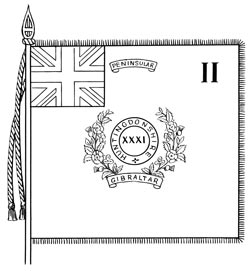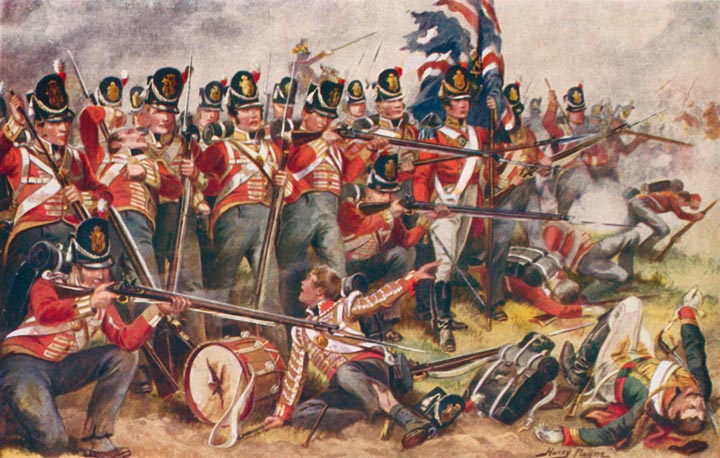The Colours of The East Surrey Regiment
(and its forebears the 31st and 70th of Foot)
Thirty-First Regiment (2nd Battalion) 1805-1814
 |
| Figure 40 |
During the Napoleonic Wars, the Regular Army expanded greatly. In common with many other regiments, the 31st raised a second battalion which received its Colours in the same year. Five years hard fighting in the Peninsular War followed, including the battles of Albuhera and Vittoria. An unusual incident involving these Colours occurred during the action at Mouguerre, near Bayonne in December 1813. Major-General Byng’s brigade, which included the 2nd/31st, was ordered to attack a strongly entrenched hill supported by artillery.
The brigade commander, a man of outstanding courage, took the King’s Colour from the Ensign and under gruelling fire led his troops to the capture of the position. The Ensign was very much upset at the time by General Byng’s unorthodox action which, he felt, reflected on his courage.
On the disbandment of the 2nd/31st, these Colours were presented to Sir John Byng, later Earl of Stafford. They are supposed to have been preserved in his ancestral home at Wrotham Park, Barnet, although in 1975 no trace of them could be found. It is thought that they were destroyed in a fire early in the twentieth century. The missing 2nd/31st Colours would have been of the six foot size. The central shield began to be changed about this time to a circular crimson patch bearing the regimental numeral and surrounded by its title.
Based on existing designs of other second battalions formed in this same period, the Regimental Colour at Wrotham Park might be as illustrated in figure 40.
The 31st Foot at Albuhera, May, 1811
The following is an extract from our Regimental History, which describes the Battle of Albuhera and the British 2nd Division being sent by Marshal Beresford as reinforcements to the right to meet Marshal Soult's attack round the Allied right: "On they came, straining every nerve to be in time, with Colborne's Brigade leading. In front were the Buffs, followed in succession by the 48th, 66th and Thirty-First. "Marshal Beresford had intended that the Second Division should be formed in line and so attack the great French column, but Major-General Stewart, who had only received general orders to support the Spaniards, decided to move up on the Spanish right and . take the French in flank. This movement might well have succeeded, and as time to Stewart seemed everything, he ordered the battalions of Colborne's brigade to hurry to the front and deploy in succession. This resulted in an echelon movement, with the Buffs clear of the Spanish right, the 48th and 66th passing through it, and the Thirty First, still in column coming up in the left rear. Now a dreadful catastrophe befell Colborne's unfortunate brigade, strung out as they were -in this weak formation. General Latour Mauburg, a brilliant cavalry leader, was waiting for an opportunity to charge, which was suddenly given him by a blinding shower of rain and hail. Under its cover the French cavalry charged the Buffs in flank and rear, rolled them up in an instant, and then swept down on the two next battalions. The word annihilation is rarely justifiable in military history, but it is stated that in five minutes these three of Colborne's four battalions lost fifty-eight officers out of eighty, and 1,160 men out of 1,568; a very large proportion were killed, Latour Mauburg's Polish Lancers showing no mercy and slaughtering the wounded. The Second Battalion Thirty-First being, as we have said, slightly in rear and still in column, happily escaped the fate of their brothers-in-arms. The French cavalry immediately attacked them, but the little battalion, which only numbered 418 of all ranks, was ably handled by Major L'Estrange, whose men displayed the finest qualities of coolness and discipline. L'Estrange, quick as thought formed square by an original manoeuvre of his own devising and had no difficulty in withstand'ing the attack of the French Lancers and Dragoons; and then having cleared his front, moved up to the summit of the hill, where he bore for a considerable time the entire brunt of the French infantry attack. In his report on this unfortunate episode of the battle. Major-General Stewart reported that the conduct of the First Brigade was very gallant; well deserved praise, for the three battalions whose formation was broken fought doggedly to the last, forming groups or rallying squares round their officers, neither asking nor receiving quarter; while the conduct of the weak battalion of the Thirty-First, in beating off the sudden attack of an imposing force of cavalry flushed with success, and commanded by one of Napoleon's finest leaders, received universal praise." Note.– Major L'Estrange's "Albuhera square" formation continued to be practised in the Thirty-First until the year 1856. |
Related

